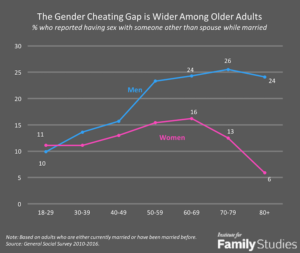An Analysis on Infidelity and Infidelity Testing. Infidelity, separations and divorce are a common occurrence in society today. Almost everyone knows someone who has had their partner cheat on them or engaged in some kind of affair. Just the same is the occurrence of divorce and separation. People often have asked the question of just how common is it for people to cheat in their relationships? The answer to this question is most accurately answered with “it depends”. It depends on a multitude of factors related to the situation and the relationship participant’s demographics. In this Analysis on Infidelity we look at some of the most well known studies or surveys on the subject.
Starting at the high end of the spectrum we have unmarried and young individuals such as college students. One such study at the Ball State University of 691 participants found that the majority of college individuals engaged in extradyadic dating and sexual activity, which is another way to describe cheating behavior in relationships.
Another study of 484 participants ages 18-35 who were originally unmarried at the beginning of the study reported the rate of infidelity to be 44% over a 5 year period.
A large survey of over 1500 people reported that 50% of participating individuals experienced cheating in their relationships
Luckily some of us decide to make our commitment to our partner official through marriage and this does happen to lower the rate of infidelity significantly.
The General Social Survey data from 2010-2016 in the United States places the rates of infidelity in marriage at an average of 20% in men and 13% in women. As you can see from the graph below the risk actually increases with age and peaks from ages 50-80.

Some other study findings to be aware of are that those who have cheated in previous relationships are 3.4 times as likely to cheat in their next relationship, certainly there is some truth to the saying “once a cheater always a cheater”. Likewise those who reported suspecting their previous partner of cheating are 4 times as likely to report that they suspect their next partner to be cheating. Therefore there is something to be said about nervous suspicion as well.
These circumstances can affect anyone in their relationship although as previously stated your demographic plays a factor. These rates can be affected by such things as political affiliation, degree of religious involvement or parenting history.
Most will claim that they will end their relationship or marriage if infidelity is discovered although some relationships survive the event. The literature is clear that infidelity is placed as either the most common reported cause of divorce on one of the most common in a collection of studies.
The estimated divorce rate in Canada according to statistics Canada is currently 38% of marriages, luckily it has decreased since the 1980’s. This is also estimated to be higher if common law marriages that end in separation are included. The results of this event as many of us know can be devastating on someone’s mental health, quality of life and their finances.
In the 2019 legal fee survey published in Canadian lawyer magazine the average cost of a contested divorce is between $7,500-$12,500. The national average cost of a 2 day trial in family court is between $13,000-$21,000 and a 5 day trial is between $23,000-$53,000.
Luckily costs like these can be insured against. For a fraction of the cost a polygraph examination for infidelity can protect you from these circumstances developing into a nightmare down the road. Finding out sooner rather than later is a great way to protect your future and well being. Just as well the peace of mind that a passed polygraph examination can give you about your relationship going forward is a very valuable thing.
We trust you found this article titled, “An Analysis on Infidelity and Infidelity Testing” insightful and should you have any questions or you’d like to schedule a consultation please contact us:
PHONE 587-819-0431 | EMAIL anavaino.inc@gmail.com | Online at https://liedetectortest.ca/
Providing Truth, Relief, and Peace of Mind.
Sources used for this article:
https://www.lovelearnings.com/breakups/why-relationships-end
Arch Sex Behav. Author manuscript; available in PMC 2018 Nov 1.
Published in final edited form as:
Arch Sex Behav. 2017 Nov; 46(8): 2301–2311.
Published online 2017 Aug 7. doi: 10.1007/s10508-017-1018-1https://www.ncbi.nlm.nih.gov/pmc/articles/PMC5709195/
Volume: 16 issue: 2, page(s): 265-274
Issue published: April 1, 1999
Ball State University
https://journals.sagepub.com/doi/10.1177/0265407599162008
https://ifstudies.org/blog/who-cheats-more-the-demographics-of-cheating-in-america
https://www.mjonions.com/divorce-rates-in-canada/
People’s Reasons for Divorcing: Gender, Social Class, the Life Course, and Adjustment
Paul R. Amato, Denise Previti First Published July 1, 2003 https://doi.org/10.1177%2F0192513X03254507
Couple Family Psychol. Author manuscript; available in PMC 2014 Jun 1.
Published in final edited form as:
Couple Family Psychol. 2013 Jun; 2(2): 131–145.
doi: 10.1037/a0032025
Oklahoma Baseline Survey (2002)
https://app.box.com/s/uoew21bvb9ertq3gqonozx0euq3laq4j
https://www.canadianlawyermag.com/staticcontent/AttachedDocs/CL_Apr_19-survey.pdf
https://www.tandfonline.com/doi/pdf/10.1080/10532528.2007.10559848?needAccess=true
https://ideas.ted.com/10-facts-about-infidelity-helen-fisher/
https://www.apa.org/pubs/journals/features/cfp-0000012.pdf
https://signalscv.com/2019/11/research-how-many-marriages-end-in-divorce-because-of-infidelity/
